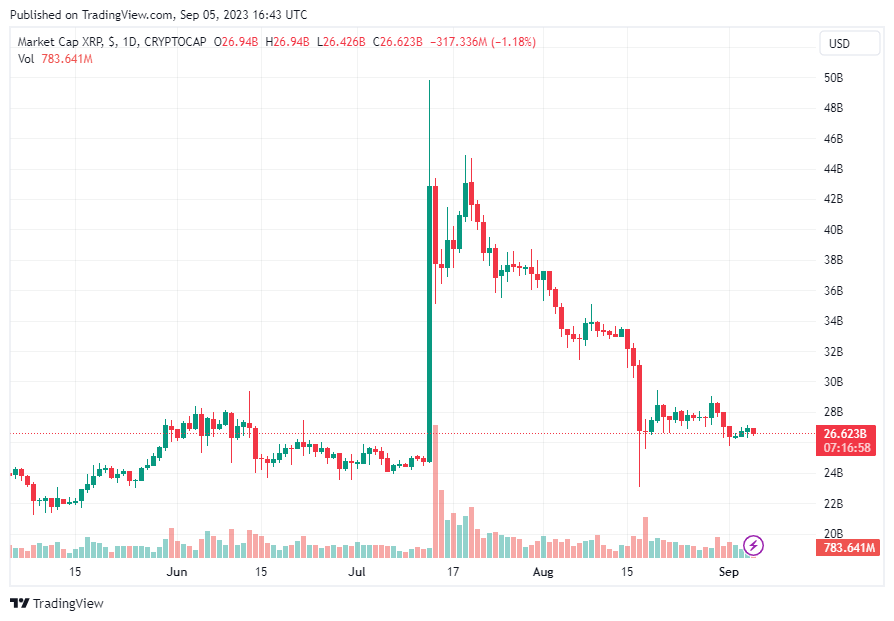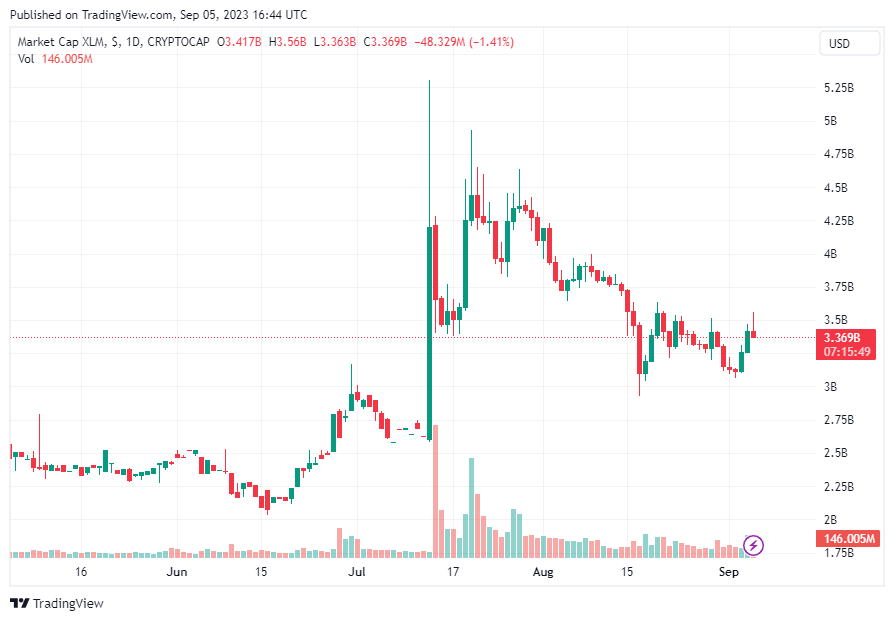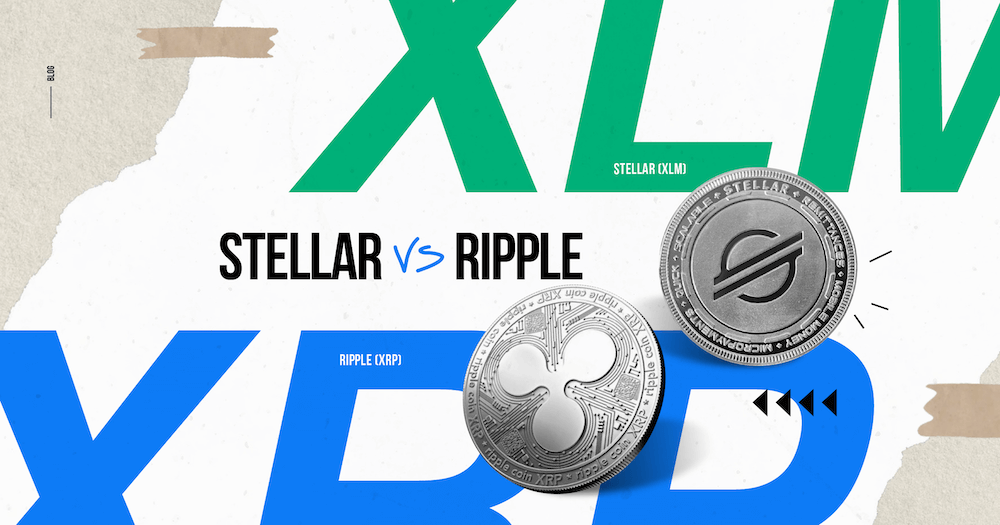
Introduction of Stellar (XLM) and Ripple (XRP)
XLM vs XRP are both valuable cryptocurrencies designed for currency transfers across borders. However, there are key distinctions between them.
Stellar is open to the public and aims to serve individuals without access to traditional banking. On the other hand, Ripple primarily caters to banks and financial institutions. Both XLM vs XRP offer fast and low-cost transfers, but they differ in their inflation and deflation mechanisms. XRP is deflationary, meaning its supply decreases over time, while XLM is inflationary, with its supply growing gradually. XRP suits those engaged in financial transactions with banks, whereas XLM targets individuals without conventional banking services. This guide explores xlm vs xrp, differences and similarities that further help you choose the cryptocurrency that aligns with your specific needs.
What is Ripple (XRP)?
Ripple is a decentralized cryptocurrency project that started in 2012 under the leadership of Ripple Labs. Its main goal is to offer swift and cost-effective international money transfers using blockchain technology. Ripple’s native token, known as XRP, ranks among the top 10 most significant cryptocurrencies by market value, trailing only Bitcoin, Ethereum, BNB, and Theater.
The foundation of Ripple’s system is the XRP Ledger, a blockchain technology. This system relies on a network of independent validators within the Ripple network, who collaborate to ensure the security and reliability of transactions. Transactions conducted on the XRP Ledger are exceptionally fast, taking only seconds to complete, which is much quicker than conventional money transfer methods.

What is Stellar (XLM)?
Stellar is a decentralized network that was created by Jed McCaleb, one of the co-founders of Ripple, along with the Stellar Development Foundation. This network officially launched in 2015 with a clear mission: to connect the global financial systems and establish a smooth protocol for financial institutions and payment providers.
Stellar aims to make it easy and inexpensive to move assets and money across borders quickly and reliably. Its goal is to bring together users, payment processors, and banks, enabling them to generate, send, and trade various cryptocurrencies. In essence, Stellar seeks to create a seamless and cost-effective way for these entities to interact and conduct financial transactions.

Similarities between XRP vs XLM
Number of Coins Limit
Both XLM vs XRP have limits on the number of coins available. Mining is not an option for these cryptocurrencies because all the coins that will ever exist have already been created. XRP has a maximum supply of 100 billion coins, while XLM has 50 billion. As of October 2021, approximately half of each of these coins is in circulation.
Fees
When it comes to fees, both networks have very low or no fees at all. This aligns with their main purpose: enabling secure and cost-effective transfers of traditional currencies. Transaction fees for XRP and XLM are consistently lower than those for equivalent fiat currencies.
Transaction Time
In terms of transaction time, both currencies are quite fast. It takes only about five to ten seconds to complete a transaction. This speedy design ensures that people can move their funds quickly, which is a significant improvement compared to the time it takes for traditional bank transfers.
Differences between XLM vs XRP
Mission
Ripple aims to enable fast and cost-effective international payments. It collaborates with financial institutions to enhance the global remittance system. In contrast, Stellar seeks to build an open network where anyone can create financial products, with a focus on aiding underdeveloped countries.
Target Audience
Ripple primarily serves major banks and financial institutions, making cross-border payments quicker and cheaper. Stellar targets lower-income and underdeveloped regions, aiming to provide banking services to the approximately 2 billion people with limited or no access to them.
Consensus Mechanism
Both Stellar and Ripple finance use advanced consensus mechanisms to validate transactions and secure their networks. Ripple employs the Ripple Protocol Consensus Algorithm, while Stellar uses the Stellar Consensus Protocol, both of which are faster than Bitcoin’s Proof-of-Work.
Partnerships
Ripple has partnered with companies like SBI Group, Western Union, American Express (not anymore), and more. Stellar collaborates with IBM World Wire, MoneyGram, Circle, and others, with a focus on real-time cross-border payments.
Token Distribution
Ripple’s native token, XRP, has a total supply of 100 billion, with over 48 billion in circulation. Stellar’s native token originally had 100 billion, but they burned 50 billion, reducing the total supply to 50 billion, due to distribution challenges.
What’s the best investment? XLM vs XRP
Choosing between Ripple (XRP) and Stellar Lumens (XLM) as an investment depends on your investor profile, risk tolerance, and goals.
For Those Who Like Speed
If you’re looking at market capitalization and funding, Ripple seems promising. It’s a well-established network with connections to global banks and payment providers. However, the outcome of Ripple’s legal case with the SEC is a crucial factor. If the SEC rules favorably for Ripple Labs, XRP could potentially reach $100. But this comes with risk, and the lawsuit is keeping XRP’s price lower for now.
Opting for Stability
Stellar Lumens, on the other hand, faces fewer challenges and its growth or decline is expected to be steadier. If you prefer a long-term investment and can patiently wait for returns, XLM might be a better choice. Stellar recently announced partnerships with VISA, Tala, and Circle, which caused a 13.4% price increase in XLM stock. As Stellar forms more partnerships, its price could continue to grow, eventually reaching $1.
Your decision depends on your risk appetite and investment horizon. Ripple offers potential for rapid growth but comes with legal uncertainties, while Stellar offers a more stable and steady path to potential returns.
Should I buy XRP and XLM?
Whether you should buy XRP and XLM or any other cryptocurrencies depends on your individual circumstances and objectives.
Conclusion
Ripple and Stellar each come with their own pros and cons. XRP is a strong choice for banks and financial institutions seeking to expedite cross-border transactions. On the other hand, Stellar is handy for individuals who want to send or receive money swiftly and affordably. It’s also known for being more decentralized compared to Ripple.
From an investment perspective, both assets have promising potential, but it’s worth noting that XRP boasts a much larger market capitalization compared to XLM. The good news is that you can find both Ripple (XRP) and Stellar (XLM) on most cryptocurrency exchanges, making them accessible to a wide range of investors.




